Overview
- Brief Narrative
- Fighter Against the Nazis medal and ribbon with box awarded to Shmuel Givol Gotthold. The ribbon was awarded on Holocaust Remembrance Day, May 7, 1967, and the medal several years later. Gotthold was a soldier in the Jewish Brigade, British Army, 2nd Jewish Battalion, Palestine Regiment. In the immediate postwar period he was stationed in the British Zone in Germany where he helped trace missing persons and aided refugees desperate to know whether their family members had survived. The Brigade was established by the British in September 1944. It included more than 5000 Jewish volunteers living in Palestine and was the only independent, national Jewish unit to serve in WWII. The unit served in combat during the final battles for the liberation of Italy. The British dissolved the Brigade in the summer 1946
- Date
-
commemoration:
1939-1945
- Geography
-
issue:
Israel
- Credit Line
- United States Holocaust Memorial Museum Collection, Gift of Yoel Givol and Michal Lilli Kahani, in memory of their grandparents, Hildegard and Moritz Henschel
- Markings
- back, bottom, engraved : Hebrew text [Fighter of the Nazis- veteran of the Second World War]
- Contributor
-
Subject:
Shmuel Givol Gotthold
Issuer: Israel
Physical Details
- Language
- Hebrew
- Classification
-
Awards
- Category
-
Medals
- Object Type
-
Medals, Israeli (lcsh)
- Physical Description
- a. Shiny, gold colored metal, circular, medal, 1.500 in. in diameter, with a raised rim and smooth edge attached to a ribbon. The front has an embossed vertical olive branch over an outlined Star of David which overlaps a recessed Star of David with an upright sword over the right side. The back is stippled and engraved with the state seal of Israel, a shield enclosing a 7 branch menorah flanked by 2 vertical olive branches above the Hebrew word for Israel. A suspension bar extends from the top attaching a threaded ribbon. The grosgrain ribbon has 9 vertical stripes: black, narrow white, narrow light blue, narrow white, wide red, narrow white, narrow light blue, narrow white, and black. The ribbon is wrapped around and adhered to a flat metal square with 2 posts with attached clutchbacks.
b. Storage box with a clear plastic lid for a dark blue plush cloth covered cardboard base with a molded inset for the medal. - Dimensions
- a: Height: 3.750 inches (9.525 cm) | Width: 1.625 inches (4.128 cm) | Depth: 0.375 inches (0.953 cm)
b: Height: 4.750 inches (12.065 cm) | Width: 2.625 inches (6.668 cm) | Depth: 0.625 inches (1.588 cm) - Materials
- a : metal, ribbon
b : cardboard, cloth, plastic
Rights & Restrictions
- Conditions on Access
- No restrictions on access
- Conditions on Use
- No restrictions on use
Keywords & Subjects
Administrative Notes
- Legal Status
- Permanent Collection
- Provenance
- The medal was donated to the United States Holocaust Memorial Museum in 2003 by Yoel Givol and Michal Lilli Kahani, the grandchildren of Hildegard and Moritz Henschel.
- Funding Note
- The cataloging of this artifact has been supported by a grant from the Conference on Jewish Material Claims Against Germany.
- Record last modified:
- 2023-08-25 08:41:17
- This page:
- https://collections.ushmm.org/search/catalog/irn539563
Download & Licensing
In-Person Research
- By Appointment
- Request 21 Days in Advance of Visit
- Plan a Research Visit
- Request to See This Object
Contact Us
Also in Hildegard and Moritz Henschel collection
The collection consists of artwork, medals, Star of David badges, books, correspondence, documents, and musical scores relating to the experiences of Moritz and Hildegard Henschel before and during the Holocaust in Berlin, Germany, during the Holocaust in Theresienstadt ghetto-labor camp, and after the Holocaust in Israel.
Date: 1840-1999
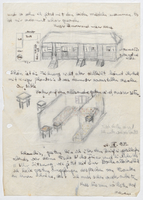
Moritz and Hildegard Henschel papers
Document
Moritz and Hildegard Henschel papers consist of documents, poems, photographs, correspondence, clippings, articles, and sheet music pertaining to Moritz Henschel’s role as director of the “Freizeitgestaltung,” in Terezin and his wife Hildegard Henschel’s experiences during this same time period. Moritz and Hildegard Henschel biographical and Theresienstadt materials include birth and marriage certificates, Red Cross correspondence, employment records, awards, medical records, poems, music, reports, identification papers, personal narratives, and clippings documenting Moritz and Hildegard Henschel, their deportation to Theresienstadt, their cultural and work life in Theresienstadt, and their liberation. Henschel family correspondence include prewar, wartime, and postwar family correspondence with Moritz and Hildegard Henschel, their daughter Lily, and Marianne Givol. Research materials acquired at the Terezin memorial document Peter Kien. Family photographs document Moritz and Hildegard Henschel and the Jewish council at Theresienstadt. Additional award decorations and certificate document Shmuel Givol Gotthold.
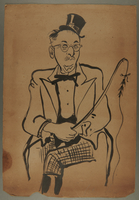
Drawing of Jewish Council member as circus ringmaster drawn by camp inmate
Object
Caricature drawn by Peter Kien for Moritz Henschel while both were imprisoned in Theresienstadt ghetto-labor camp. It depicts Moritz as a circus ringmaster. Moritz was a member of the Jewish Council in the camp and Kien was an influential artist and playwright who also designed the camp currency. Kien was deported to Auschwitz in October 1944 and died soon after arrival. Moritz was an influential lawyer in Berlin when Hitler came to power in Germany in January 1933. As the government persecution of Jews intensified, Moritz and Hildegard sent their daughters Marianne, 15, to Palestine and Lilly, 13, to England in 1939. Moritz was on the board of the Reich Association of Jews in Germany, created by the Nazi government in February 1939 to organize Jewish affairs. The Association was eventually forced to assist with deportations. Moritz also became president of the Berlin Jewish Community. In January 1943, Moritz became president of the Reich Association, when Leo Baeck was deported. On June 10, 1943, the Reich Association was shut down and Moritz and Hildegard were deported to Theresienstadt on June 16. Moritz was elected to the Jewish Council and put in charge of the Freizeitgestaltung, which produced cultural materials and events. On May 9, 1945, the camp was liberated by Soviet forces. Moritz and Hildegard went to Deggendorf displaced persons camp, then emigrated to Palestine in 1946.
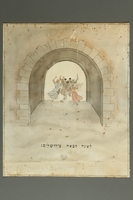
Jo Spier watercolor of people dancing through a gate and given to another inmate
Object
Watercolor drawing created by Jo Spier and given to Moritz and Hildegard Henschel while they were imprisoned in Theresienstadt ghetto-labor camp from June 1943-May 1945. It shows people dancing through a stone gate, leaving behind a trail of Star of David badges. Spier, a Jewish artist from the Netherlands, was arrested for creating a satirical cartoon of Hitler in 1943 and deported to Theresienstadt with his wife and three children. They returned to Amsterdam after liberation. Moritz was an influential lawyer in Berlin when Hitler came to power in Germany in January 1933. As government persecution of Jews intensified, Moritz and Hildegard sent their daughters Marianne, 15, to Palestine and Lilly, 13, to England in 1939. Moritz was on the board of the Reich Association of Jews in Germany, created by the Nazi government in February 1939 to organize Jewish affairs. The Association was eventually forced to assist with deportations. In 1940, Moritz became president of the Berlin Jewish Community. In January 1943, Moritz became president of the Reich Association, when Leo Baeck was deported. On June 10, 1943, the Reich Association was shut down and Moritz and Hildegard were deported to Theresienstadt. Moritz was elected to the Jewish Council and put in charge of the Freizeitgestaltung, which produced cultural events and materials. On May 9, 1945, the camp was liberated by Soviet forces. Moritz and Hildegard went to Deggendorf displaced persons camp, then immigrated to Palestine in 1946.

WWI Red Cross merit medal, 3rd class awarded to German Jewish woman
Object
German Rothe Kreuz [For Merit in the Red Corss] medal, 3rd class, awarded to Hildegard Alexander for her service as a nurse in World War I (1914-1918). See 2003.361.19 for the Rothe Kreuz ribbon she was also awarded. Her husband, Moritz Henschel, had been decorated for his service in the German Army during the war. Moritz was an influential lawyer in Berlin when Hitler came to power in Germany in January 1933. As government persecution of Jews intensified, Moritz and Hildegard sent their daughters Marianne, 15, to Palestine and Lilly, 13, to England in 1939. Moritz was on the board of the Reich Association of Jews in Germany, created by the Nazi government in February 1939 to organize Jewish affairs. The Association was eventually forced to assist with deportations. In 1940, Moritz became president of the Berlin Jewish Community. In January 1943, Moritz became president of the Reich Association, when Leo Baeck was deported. On June 10, 1943, the Reich Association was shut down and Moritz and Hildegard were deported to Theresienstadt. Moritz was elected to the Jewish Council and put in charge of the Freizeitgestaltung, which produced cultural events and materials. On May 9, 1945, the camp was liberated by Soviet forces. Moritz and Hildegard went to Deggendorf displaced persons camp, then emigrated to Palestine in 1946.
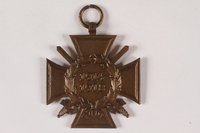
Iron Cross, 2nd class, 2 ribbons, and box awarded to a German Jewish soldier for bravery in WWI
Object
Iron Cross 2nd Class medal awarded to Moritz Henschel for his bravery on August 14, 1915, on the Italian front in World War I (1914-1918.) Moritz was an influential lawyer in Berlin when Hitler came to power in Germany in January 1933. As government persecution of Jews intensified, Moritz and Hildegard sent their daughters Marianne, 15, to Palestine and Lilly, 13, to England in 1939. Moritz was on the board of the Reich Association of Jews in Germany, created by the Nazi government in February 1939 to organize Jewish affairs. The Association was eventually forced to assist with deportations. In 1940, Moritz became president of the Berlin Jewish Community. In January 1943, Moritz became president of the Reich Association, when Leo Baeck was deported. On June 10, 1943, the Reich Association was shut down and Moritz and Hildegard were deported to Theresienstadt. Moritz was elected to the Jewish Council and put in charge of the Freizeitgestaltung, which produced cultural events and materials. On May 9, 1945, the camp was liberated by Soviet forces. Moritz and Hildegard went to Deggendorf displaced persons camp, then emigrated to Palestine in 1946.
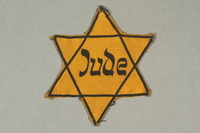
Star of David badge imprinted Jude worn by a German Jew
Object
Star of David badge worn by Moritz or Hildegard Henschel who were deported from Berlin to Theresienstadt ghetto-labor camp in June 1943. Moritz was an influential lawyer in Berlin when Hitler came to power in Germany in January 1933. As government persecution of Jews intensified, Moritz and Hildegard sent their daughters Marianne, 15, to Palestine and Lilly, 13, to England in 1939. Moritz was on the board of the Reich Association of Jews in Germany, created by the Nazi government in February 1939 to organize Jewish affairs. The Association was eventually forced to assist with deportations. In 1940, Moritz became president of the Berlin Jewish Community. In January 1943, Moritz became president of the Reich Association, when Leo Baeck was deported. On June 10, 1943, the Reich Association was shut down and Moritz and Hildegard were deported to Theresienstadt. Moritz was elected to the Jewish Council and put in charge of the Freizeitgestaltung, which produced cultural events and materials. On May 9, 1945, the camp was liberated by Soviet forces. Moritz and Hildegard went to Deggendorf displaced persons camp, then emigrated to Palestine in 1946.
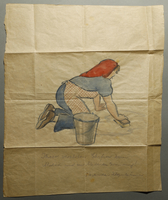
Drawing of woman scrubbing floor given to German Jewish inmate
Object
Color drawing of a woman washing the floor given to Hildegard Henschel while she and her husband Moritz were imprisoned in Theresienstadt ghetto-labor camp from June 1943-May 1945. Moritz was an influential lawyer in Berlin when Hitler came to power in Germany in January 1933. As government persecution of Jews intensified, Moritz and Hildegard sent their daughters Marianne, 15, to Palestine and Lilly, 13, to England in 1939. Moritz was on the board of the Reich Association of Jews in Germany, created by the Nazi government in February 1939 to organize Jewish affairs. The Association was eventually forced to assist with deportations. In 1940, Moritz became president of the Berlin Jewish Community. In January 1943, Moritz became president of the Reich Association, when Leo Baeck was deported. On June 10, 1943, the Reich Association was shut down and Moritz and Hildegard were deported to Theresienstadt. Moritz was elected to the Jewish Council and put in charge of the Freizeitgestaltung, which produced cultural events and materials. On May 9, 1945, the camp was liberated by Soviet forces. Moritz and Hildegard went to Deggendorf displaced persons camp, then emigrated to Palestine in 1946.
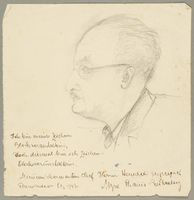
Portrait of a Theresienstadt inmate drawn by another inmate
Object
Portrait drawing of Moritz Henschel by Myra Strauss Rutenberg given to Moritz while he and his wife Hildegard were imprisoned in Theresienstadt ghetto-labor camp from June 1943-May 1945. Moritz was an influential lawyer in Berlin when Hitler came to power in Germany in January 1933. As government persecution of Jews intensified, Moritz and Hildegard sent their daughters Marianne, 15, to Palestine and Lilly, 13, to England in 1939. Moritz was on the board of the Reich Association of Jews in Germany, created by the Nazi government in February 1939 to organize Jewish affairs. The Association was eventually forced to assist with deportations. In 1940, Moritz became president of the Berlin Jewish Community. In January 1943, Moritz became president of the Reich Association, when Leo Baeck was deported. On June 10, 1943, the Reich Association was shut down and Moritz and Hildegard were deported to Theresienstadt. Moritz was elected to the Jewish Council and put in charge of the Freizeitgestaltung, which produced cultural events and materials. On May 9, 1945, the camp was liberated by Soviet forces. Moritz and Hildegard went to Deggendorf displaced persons camp, then emigrated to Palestine in 1946.
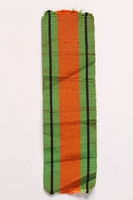
British Defence Medal 1939-1945 ribbon awarded to Jewish Brigade veteran
Object
British Defence Medal 1939-1945 ribbon awarded to Shmuel Givol Gotthold. Gotthold was a soldier in the Jewish Brigade, British Army, 2nd Jewish Battalion, Palestine Regiment. In the immediate postwar period he was stationed in the British Zone in Germany where he helped trace missing persons and aided refugees desperate to know whether their family members had survived. The Brigade was established by the British in September 1944. It included more than 5000 Jewish volunteers living in Palestine and was the only independent, national Jewish unit to serve in WWII. The unit served in combat during the final battles for the liberation of Italy. The British dissolved the Brigade in the summer 1946
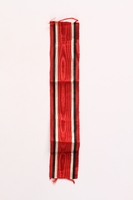
WWI Red Cross medal ribbon awarded to German Jewish woman
Object
Rothe Kreuz [For Merit in the Red Cross] medal ribbon awarded to Hildegard Alexander for her service as a nurse in World War I (1914-1918). See 2003.361.8 for the Rothe Kreuz medal she was also awarded. Her husband, Moritz Henschel, had been decorated for his service in the German Army during the war. Moritz was an influential lawyer in Berlin when Hitler came to power in Germany in January 1933. As government persecution of Jews intensified, Moritz and Hildegard sent their daughters Marianne, 15, to Palestine and Lilly, 13, to England in 1939. Moritz was on the board of the Reich Association of Jews in Germany, created by the Nazi government in February 1939 to organize Jewish affairs. The Association was eventually forced to assist with deportations. In 1940, Moritz became president of the Berlin Jewish Community. In January 1943, Moritz became president of the Reich Association, when Leo Baeck was deported. On June 10, 1943, the Reich Association was shut down and Moritz and Hildegard were deported to Theresienstadt. Moritz was elected to the Jewish Council and put in charge of the Freizeitgestaltung, which produced cultural events and materials. On May 9, 1945, the camp was liberated by Soviet forces. Moritz and Hildegard went to Deggendorf displaced persons camp, then emigrated to Palestine in 1946.
Book
Object
Book of Goethe's writings taken from the Theresienstadt ghetto library by Moritz Henschel, who was imprisoned there from June 1943 - May 1945. Moritz was an influential lawyer in Berlin when Hitler came to power in Germany in January 1933. As the government persecution of Jews intensified, Moritz and Hildegard sent their daughters Marianne, 15, to Palestine and Lilly, 13, to England in 1939. Moritz was on the board of the Reich Association of Jews in Germany, created by the Nazi government in February 1939 to organize Jewish affairs. The Association was eventually forced to assist with deportations. In 1940, Moritz also became president of the Berlin Jewish Community. In January 1943, Moritz became president of the Reich Association, when Leo Baeck was deported. On June 10, 1943, the Reich Association was shut down and Moritz and Hildegard were deported to Theresienstadt. Moritz was elected to the Jewish Council and put in charge of the Freizeitgestaltung, which produced cultural events and materials. On May 9, 1945, the camp was liberated by Soviet forces. Moritz and Hildegard went to Deggendorf displaced persons camp in Germany, then emigrated to Palestine in 1946.
Book
Object
Book of Horace's writings taken from the Theresienstadt ghetto library by Moritz Henschel, who was imprisoned there from June 1943 - May 1945. Moritz was an influential lawyer in Berlin when Hitler came to power in Germany in January 1933. As the government persecution of Jews intensified, Moritz and Hildegard sent their daughters Marianne, 15, to Palestine and Lilly, 13, to England in 1939. Moritz was on the board of the Reich Association of Jews in Germany, created by the Nazi government in February 1939 to organize Jewish affairs. The Association was eventually forced to assist with deportations. In 1940, Moritz also became president of the Berlin Jewish Community. In January 1943, Moritz became president of the Reich Association, when Leo Baeck was deported. On June 10, 1943, the Reich Association was shut down and Moritz and Hildegard were deported to Theresienstadt. Moritz was elected to the Jewish Council and put in charge of the Freizeitgestaltung, which produced cultural events and materials. On May 9, 1945, the camp was liberated by Soviet forces. Moritz and Hildegard went to Deggendorf displaced persons camp in Germany, then emigrated to Palestine in 1946.
Signed print of rabbi saved by German Jewish camp inmate
Object
Portrait print of Rabbi Guttmann saved by Moritz and Hildegard Henschel from their imprisonment in Theresienstadt ghetto-labor camp between June 1943 and May 1945. The Rabbi and the artist were prominent citizens of Breslau, which was Moritz's home town. Moritz was an influential lawyer in Berlin when Hitler came to power in Germany in January 1933. As government persecution of Jews intensified, Moritz and Hildegard sent their daughters Marianne, 15, to Palestine and Lilly, 13, to England in 1939. Moritz was on the board of the Reich Association of Jews in Germany, created by the Nazi government in February 1939 to organize Jewish affairs. The Association was eventually forced to assist with deportations. Moritz also became president of the Berlin Jewish Community. In January 1943, Moritz became president of the Reich Association, when Leo Baeck was deported. On June 10, 1943, the Reich Association was shut down and Moritz and Hildegard were deported to Theresienstadt. Moritz was elected to the Jewish Council and put in charge of the Freizeitgestaltung, which produced cultural events and materials. On May 9, 1945, the camp was liberated by Soviet forces. Moritz and Hildegard went to Deggendorf displaced persons camp, then emigrated to Palestine in 1946.
Watercolor of an oasis with animals made for a German Jewish camp inmate
Object
Humorous drawing of animals in an oasis inscribed to Hildegard Henschel and given to her husband Moritz in April 1944, when they were prisoners in Theresienstadt ghetto-labor camp. Moritz was an influential lawyer in Berlin when Hitler came to power in Germany in January 1933. As government persecution of Jews intensified, Moritz and Hildegard sent their daughters Marianne, 15, to Palestine and Lilly, 13, to England in 1939. Moritz was on the board of the Reich Association of Jews in Germany, created by the Nazi government in February 1939 to organize Jewish affairs. The Association was eventually forced to assist with deportations. In 1940, Moritz became president of the Berlin Jewish Community. In January 1943, Moritz became president of the Reich Association, when Leo Baeck was deported. On June 10, 1943, the Reich Association was shut down and Moritz and Hildegard were deported to Theresienstadt. Moritz was elected to the Jewish Council and put in charge of the Freizeitgestaltung, which produced cultural events and materials. On May 9, 1945, the camp was liberated by Soviet forces. Moritz and Hildegard went to Deggendorf displaced persons camp, then emigrated to Palestine in 1946.
Star of David badge imprinted Jude worn by a German Jew
Object
Star of David badge worn by Moritz or Hildegard Henschel who were deported from Berlin to Theresienstadt ghetto-labor camp in June 1943. Moritz was an influential lawyer in Berlin when Hitler came to power in Germany in January 1933. As government persecution of Jews intensified, Moritz and Hildegard sent their daughters Marianne, 15, to Palestine and Lilly, 13, to England in 1939. Moritz was on the board of the Reich Association of Jews in Germany, created by the Nazi government in February 1939 to organize Jewish affairs. The Association was eventually forced to assist with deportations. In 1940, Moritz became president of the Berlin Jewish Community. In January 1943, Moritz became president of the Reich Association, when Leo Baeck was deported. On June 10, 1943, the Reich Association was shut down and Moritz and Hildegard were deported to Theresienstadt. Moritz was elected to the Jewish Council and put in charge of the Freizeitgestaltung, which produced cultural events and materials. On May 9, 1945, the camp was liberated by Soviet forces. Moritz and Hildegard went to Deggendorf displaced persons camp, then emigrated to Palestine in 1946.
Star of David badge imprinted Jude worn by a German Jew
Object
Star of David badge worn by Moritz or Hildegard Henschel who were deported from Berlin to Theresienstadt ghetto-labor camp in June 1943. Moritz was an influential lawyer in Berlin when Hitler came to power in Germany in January 1933. As government persecution of Jews intensified, Moritz and Hildegard sent their daughters Marianne, 15, to Palestine and Lilly, 13, to England in 1939. Moritz was on the board of the Reich Association of Jews in Germany, created by the Nazi government in February 1939 to organize Jewish affairs. The Association was eventually forced to assist with deportations. In 1940, Moritz became president of the Berlin Jewish Community. In January 1943, Moritz became president of the Reich Association, when Leo Baeck was deported. On June 10, 1943, the Reich Association was shut down and Moritz and Hildegard were deported to Theresienstadt. Moritz was elected to the Jewish Council and put in charge of the Freizeitgestaltung, which produced cultural events and materials. On May 9, 1945, the camp was liberated by Soviet forces. Moritz and Hildegard went to Deggendorf displaced persons camp, then emigrated to Palestine in 1946.
Star of David badge imprinted Jude worn by a German Jew
Object
Star of David badge worn by Moritz or Hildegard Henschel who were deported from Berlin to Theresienstadt ghetto-labor camp in June 1943. Moritz was an influential lawyer in Berlin when Hitler came to power in Germany in January 1933. As government persecution of Jews intensified, Moritz and Hildegard sent their daughters Marianne, 15, to Palestine and Lilly, 13, to England in 1939. Moritz was on the board of the Reich Association of Jews in Germany, created by the Nazi government in February 1939 to organize Jewish affairs. The Association was eventually forced to assist with deportations. In 1940, Moritz became president of the Berlin Jewish Community. In January 1943, Moritz became president of the Reich Association, when Leo Baeck was deported. On June 10, 1943, the Reich Association was shut down and Moritz and Hildegard were deported to Theresienstadt. Moritz was elected to the Jewish Council and put in charge of the Freizeitgestaltung, which produced cultural events and materials. On May 9, 1945, the camp was liberated by Soviet forces. Moritz and Hildegard went to Deggendorf displaced persons camp, then emigrated to Palestine in 1946.
Star of David badge imprinted Jude worn by a German Jew
Object
Star of David badge worn by Moritz or Hildegard Henschel who were deported from Berlin to Theresienstadt ghetto-labor camp in June 1943. Moritz was an influential lawyer in Berlin when Hitler came to power in Germany in January 1933. As government persecution of Jews intensified, Moritz and Hildegard sent their daughters Marianne, 15, to Palestine and Lilly, 13, to England in 1939. Moritz was on the board of the Reich Association of Jews in Germany, created by the Nazi government in February 1939 to organize Jewish affairs. The Association was eventually forced to assist with deportations. In 1940, Moritz became president of the Berlin Jewish Community. In January 1943, Moritz became president of the Reich Association, when Leo Baeck was deported. On June 10, 1943, the Reich Association was shut down and Moritz and Hildegard were deported to Theresienstadt. Moritz was elected to the Jewish Council and put in charge of the Freizeitgestaltung, which produced cultural events and materials. On May 9, 1945, the camp was liberated by Soviet forces. Moritz and Hildegard went to Deggendorf displaced persons camp, then emigrated to Palestine in 1946.
Theresienstadt ghetto-labor camp, 10,000 kronen scrip band owned by inmates
Object
Paper band for stack of Theresienstadt 10,000 kronen notes owned by Hildegard and Moritz Henschel who were interned in Theresienstadt ghetto-labor camp in German occupied Czechoslovakia from June 1943-May 1945. Moritz and Hildegard were Berlin residents when Hitler came to power in Germany in January 1933. As persecution of Jews intensified, Moritz and Hildegard sent their daughters Marianne, 15, to Palestine and Lilly, 13, to England in 1939. Moritz was on the board of the Reich Association of Jews in Germany which was forced to assist with deportations. In 1940, Moritz became president of the Berlin Jewish Community. In January 1943, Moritz became president of the Reich Association. When it was shut down on June 10, 1943, Moritz and Hildegard were deported to Theresienstadt. Moritz was elected to the Jewish Council and put in charge of the Freizeitgestaltung, which produced cultural events and materials. On May 9, 1945, the camp was liberated by Soviet forces. Moritz and Hildegard went to Deggendorf displaced persons camp, then emigrated to Palestine in 1946.
Theresienstadt ghetto-labor camp scrip, 1 krone note owned by former inmates
Object
Theresienstadt ghetto-labor camp scrip, 1 [eine] krone note owned by Hildegard and Moritz Henschel who were interned in Theresienstadt ghetto-labor camp in German occupied Czechoslovakia from June 1943-May 1945. Moritz and Hildegard were Berlin residents when Hitler came to power in Germany in January 1933. As persecution of Jews intensified, Moritz and Hildegard sent their daughters Marianne, 15, to Palestine and Lilly, 13, to England in 1939. Moritz was on the board of the Reich Association of Jews in Germany which was forced to assist with deportations. In 1940, Moritz became president of the Berlin Jewish Community. In January 1943, Moritz became president of the Reich Association. When it was shut down on June 10, 1943, Moritz and Hildegard were deported to Theresienstadt. Moritz was elected to the Jewish Council and put in charge of the Freizeitgestaltung, which produced cultural events and materials. On May 9, 1945, the camp was liberated by Soviet forces. Moritz and Hildegard went to Deggendorf displaced persons camp, then emigrated to Palestine in 1946.
Theresienstadt ghetto-labor camp scrip, 2 kronen note owned by former inmates
Object
Theresienstadt ghetto-labor camp scrip, 2 [zwei] kronen note owned by Hildegard and Moritz Henschel who were interned in Theresienstadt ghetto-labor camp in German occupied Czechoslovakia from June 1943-May 1945. Moritz and Hildegard were Berlin residents when Hitler came to power in Germany in January 1933. As persecution of Jews intensified, Moritz and Hildegard sent their daughters Marianne, 15, to Palestine and Lilly, 13, to England in 1939. Moritz was on the board of the Reich Association of Jews in Germany which was forced to assist with deportations. In 1940, Moritz became president of the Berlin Jewish Community. In January 1943, Moritz became president of the Reich Association. When it was shut down on June 10, 1943, Moritz and Hildegard were deported to Theresienstadt. Moritz was elected to the Jewish Council and put in charge of the Freizeitgestaltung, which produced cultural events and materials. On May 9, 1945, the camp was liberated by Soviet forces. Moritz and Hildegard went to Deggendorf displaced persons camp, then emigrated to Palestine in 1946.
Theresienstadt ghetto-labor camp scrip, 5 kronen note owned by former inmates
Object
Theresienstadt ghetto-labor camp scrip, 5 [funf] kronen note owned by Hildegard and Moritz Henschel who were interned in Theresienstadt ghetto-labor camp in German occupied Czechoslovakia from June 1943-May 1945. Moritz and Hildegard were Berlin residents when Hitler came to power in Germany in January 1933. As persecution of Jews intensified, Moritz and Hildegard sent their daughters Marianne, 15, to Palestine and Lilly, 13, to England in 1939. Moritz was on the board of the Reich Association of Jews in Germany which was forced to assist with deportations. In 1940, Moritz became president of the Berlin Jewish Community. In January 1943, Moritz became president of the Reich Association. When it was shut down on June 10, 1943, Moritz and Hildegard were deported to Theresienstadt. Moritz was elected to the Jewish Council and put in charge of the Freizeitgestaltung, which produced cultural events and materials. On May 9, 1945, the camp was liberated by Soviet forces. Moritz and Hildegard went to Deggendorf displaced persons camp, then emigrated to Palestine in 1946.
Theresienstadt ghetto-labor camp scrip, 10 kronen note owned by former inmates
Object
Theresienstadt ghetto-labor camp scrip, 10 [zehn] kronen note owned by Hildegard and Moritz Henschel who were interned in Theresienstadt ghetto-labor camp in German occupied Czechoslovakia from June 1943-May 1945. Moritz and Hildegard were Berlin residents when Hitler came to power in Germany in January 1933. As persecution of Jews intensified, Moritz and Hildegard sent their daughters Marianne, 15, to Palestine and Lilly, 13, to England in 1939. Moritz was on the board of the Reich Association of Jews in Germany which was forced to assist with deportations. In 1940, Moritz became president of the Berlin Jewish Community. In January 1943, Moritz became president of the Reich Association. When it was shut down on June 10, 1943, Moritz and Hildegard were deported to Theresienstadt. Moritz was elected to the Jewish Council and put in charge of the Freizeitgestaltung, which produced cultural events and materials. On May 9, 1945, the camp was liberated by Soviet forces. Moritz and Hildegard went to Deggendorf displaced persons camp, then emigrated to Palestine in 1946.
Theresienstadt ghetto-labor camp scrip, 20 kronen note owned by former inmates
Object
Theresienstadt ghetto-labor camp scrip, 20 [zwanzig] kronen note owned by Hildegard and Moritz Henschel who were interned in Theresienstadt ghetto-labor camp in German occupied Czechoslovakia from June 1943-May 1945. Moritz and Hildegard were Berlin residents when Hitler came to power in Germany in January 1933. As persecution of Jews intensified, Moritz and Hildegard sent their daughters Marianne, 15, to Palestine and Lilly, 13, to England in 1939. Moritz was on the board of the Reich Association of Jews in Germany which was forced to assist with deportations. In 1940, Moritz became president of the Berlin Jewish Community. In January 1943, Moritz became president of the Reich Association. When it was shut down on June 10, 1943, Moritz and Hildegard were deported to Theresienstadt. Moritz was elected to the Jewish Council and put in charge of the Freizeitgestaltung, which produced cultural events and materials. On May 9, 1945, the camp was liberated by Soviet forces. Moritz and Hildegard went to Deggendorf displaced persons camp, then emigrated to Palestine in 1946.
Theresienstadt ghetto-labor camp scrip, 50 kronen note owned by former inmates
Object
Theresienstadt ghetto-labor camp scrip, 50 [funfzig] kronen note owned by Hildegard and Moritz Henschel who were interned in Theresienstadt ghetto-labor camp in German occupied Czechoslovakia from June 1943-May 1945. Moritz and Hildegard were Berlin residents when Hitler came to power in Germany in January 1933. As persecution of Jews intensified, Moritz and Hildegard sent their daughters Marianne, 15, to Palestine and Lilly, 13, to England in 1939. Moritz was on the board of the Reich Association of Jews in Germany which was forced to assist with deportations. In 1940, Moritz became president of the Berlin Jewish Community. In January 1943, Moritz became president of the Reich Association. When it was shut down on June 10, 1943, Moritz and Hildegard were deported to Theresienstadt. Moritz was elected to the Jewish Council and put in charge of the Freizeitgestaltung, which produced cultural events and materials. On May 9, 1945, the camp was liberated by Soviet forces. Moritz and Hildegard went to Deggendorf displaced persons camp, then emigrated to Palestine in 1946.
Theresienstadt ghetto-labor camp scrip, 100 kronen note owned by former inmates
Object
Theresienstadt ghetto-labor camp scrip, 100 [hundert] kronen note owned by Hildegard and Moritz Henschel who were interned in Theresienstadt ghetto-labor camp in German occupied Czechoslovakia from June 1943-May 1945. Moritz and Hildegard were Berlin residents when Hitler came to power in Germany in January 1933. As persecution of Jews intensified, Moritz and Hildegard sent their daughters Marianne, 15, to Palestine and Lilly, 13, to England in 1939. Moritz was on the board of the Reich Association of Jews in Germany which was forced to assist with deportations. In 1940, Moritz became president of the Berlin Jewish Community. In January 1943, Moritz became president of the Reich Association. When it was shut down on June 10, 1943, Moritz and Hildegard were deported to Theresienstadt. Moritz was elected to the Jewish Council and put in charge of the Freizeitgestaltung, which produced cultural events and materials. On May 9, 1945, the camp was liberated by Soviet forces. Moritz and Hildegard went to Deggendorf displaced persons camp, then emigrated to Palestine in 1946.
Theresienstadt ghetto-labor camp scrip, 100 kronen note owned by former inmates
Object
Theresienstadt ghetto-labor camp scrip, 100 [hundert] kronen note owned by Hildegard and Moritz Henschel who were interned in Theresienstadt ghetto-labor camp in German occupied Czechoslovakia from June 1943-May 1945. Moritz and Hildegard were Berlin residents when Hitler came to power in Germany in January 1933. As persecution of Jews intensified, Moritz and Hildegard sent their daughters Marianne, 15, to Palestine and Lilly, 13, to England in 1939. Moritz was on the board of the Reich Association of Jews in Germany which was forced to assist with deportations. In 1940, Moritz became president of the Berlin Jewish Community. In January 1943, Moritz became president of the Reich Association. When it was shut down on June 10, 1943, Moritz and Hildegard were deported to Theresienstadt. Moritz was elected to the Jewish Council and put in charge of the Freizeitgestaltung, which produced cultural events and materials. On May 9, 1945, the camp was liberated by Soviet forces. Moritz and Hildegard went to Deggendorf displaced persons camp, then emigrated to Palestine in 1946.
Theresienstadt ghetto-labor camp, 5,000 kronen scrip band by former inmates
Object
Paper band for stack of 5,000 kronen Theresienstadt scrip owned by Hildegard and Moritz Henschel who were interned in Theresienstadt ghetto-labor camp in German occupied Czechoslovakia from June 1943-May 1945. Moritz and Hildegard were Berlin residents when Hitler came to power in Germany in January 1933. As persecution of Jews intensified, Moritz and Hildegard sent their daughters Marianne, 15, to Palestine and Lilly, 13, to England in 1939. Moritz was on the board of the Reich Association of Jews in Germany which was forced to assist with deportations. In 1940, Moritz became president of the Berlin Jewish Community. In January 1943, Moritz became president of the Reich Association. When it was shut down on June 10, 1943, Moritz and Hildegard were deported to Theresienstadt. Moritz was elected to the Jewish Council and put in charge of the Freizeitgestaltung, which produced cultural events and materials. On May 9, 1945, the camp was liberated by Soviet forces. Moritz and Hildegard went to Deggendorf displaced persons camp, then emigrated to Palestine in 1946.
Theresienstadt ghetto-labor camp scrip, 1 krone note owned by former inmates
Object
Theresienstadt ghetto-labor camp scrip, 1[eine] krone note owned by Hildegard and Moritz Henschel who were interned in Theresienstadt ghetto-labor camp in German occupied Czechoslovakia from June 1943-May 1945. Moritz and Hildegard were Berlin residents when Hitler came to power in Germany in January 1933. As persecution of Jews intensified, Moritz and Hildegard sent their daughters Marianne, 15, to Palestine and Lilly, 13, to England in 1939. Moritz was on the board of the Reich Association of Jews in Germany which was forced to assist with deportations. In 1940, Moritz became president of the Berlin Jewish Community. In January 1943, Moritz became president of the Reich Association. When it was shut down on June 10, 1943, Moritz and Hildegard were deported to Theresienstadt. Moritz was elected to the Jewish Council and put in charge of the Freizeitgestaltung, which produced cultural events and materials. On May 9, 1945, the camp was liberated by Soviet forces. Moritz and Hildegard went to Deggendorf displaced persons camp, then emigrated to Palestine in 1946.
Theresienstadt ghetto-labor camp scrip, 2 kronen note owned by former inmates
Object
Theresienstadt ghetto-labor camp scrip, 2 [zwei] kronen note owned by Hildegard and Moritz Henschel who were interned in Theresienstadt ghetto-labor camp in German occupied Czechoslovakia from June 1943-May 1945. Moritz and Hildegard were Berlin residents when Hitler came to power in Germany in January 1933. As persecution of Jews intensified, Moritz and Hildegard sent their daughters Marianne, 15, to Palestine and Lilly, 13, to England in 1939. Moritz was on the board of the Reich Association of Jews in Germany which was forced to assist with deportations. In 1940, Moritz became president of the Berlin Jewish Community. In January 1943, Moritz became president of the Reich Association. When it was shut down on June 10, 1943, Moritz and Hildegard were deported to Theresienstadt. Moritz was elected to the Jewish Council and put in charge of the Freizeitgestaltung, which produced cultural events and materials. On May 9, 1945, the camp was liberated by Soviet forces. Moritz and Hildegard went to Deggendorf displaced persons camp, then emigrated to Palestine in 1946.
Theresienstadt ghetto-labor camp scrip, 10 kronen note owned by former inmates
Object
Theresienstadt ghetto-labor camp scrip, 10 [zehn] kronen note owned by Hildegard and Moritz Henschel who were interned in Theresienstadt ghetto-labor camp in German occupied Czechoslovakia from June 1943-May 1945. Moritz and Hildegard were Berlin residents when Hitler came to power in Germany in January 1933. As persecution of Jews intensified, Moritz and Hildegard sent their daughters Marianne, 15, to Palestine and Lilly, 13, to England in 1939. Moritz was on the board of the Reich Association of Jews in Germany which was forced to assist with deportations. In 1940, Moritz became president of the Berlin Jewish Community. In January 1943, Moritz became president of the Reich Association. When it was shut down on June 10, 1943, Moritz and Hildegard were deported to Theresienstadt. Moritz was elected to the Jewish Council and put in charge of the Freizeitgestaltung, which produced cultural events and materials. On May 9, 1945, the camp was liberated by Soviet forces. Moritz and Hildegard went to Deggendorf displaced persons camp, then emigrated to Palestine in 1946.
Theresienstadt ghetto-labor camp scrip, 20 kronen note owned by former inmates
Object
Theresienstadt ghetto-labor camp scrip, 20 [zwanzig] kronen note owned by Hildegard and Moritz Henschel who were interned in Theresienstadt ghetto-labor camp in German occupied Czechoslovakia from June 1943-May 1945. Moritz and Hildegard were Berlin residents when Hitler came to power in Germany in January 1933. As persecution of Jews intensified, Moritz and Hildegard sent their daughters Marianne, 15, to Palestine and Lilly, 13, to England in 1939. Moritz was on the board of the Reich Association of Jews in Germany which was forced to assist with deportations. In 1940, Moritz became president of the Berlin Jewish Community. In January 1943, Moritz became president of the Reich Association. When it was shut down on June 10, 1943, Moritz and Hildegard were deported to Theresienstadt. Moritz was elected to the Jewish Council and put in charge of the Freizeitgestaltung, which produced cultural events and materials. On May 9, 1945, the camp was liberated by Soviet forces. Moritz and Hildegard went to Deggendorf displaced persons camp, then emigrated to Palestine in 1946.
Theresienstadt ghetto-labor camp scrip, 5 kronen note owned by former inmates
Object
Theresienstadt ghetto-labor camp scrip, 5 [funf] kronen note owned by Hildegard and Moritz Henschel who were interned in Theresienstadt ghetto-labor camp in German occupied Czechoslovakia from June 1943-May 1945. Moritz and Hildegard were Berlin residents when Hitler came to power in Germany in January 1933. As persecution of Jews intensified, Moritz and Hildegard sent their daughters Marianne, 15, to Palestine and Lilly, 13, to England in 1939. Moritz was on the board of the Reich Association of Jews in Germany which was forced to assist with deportations. In 1940, Moritz became president of the Berlin Jewish Community. In January 1943, Moritz became president of the Reich Association. When it was shut down on June 10, 1943, Moritz and Hildegard were deported to Theresienstadt. Moritz was elected to the Jewish Council and put in charge of the Freizeitgestaltung, which produced cultural events and materials. On May 9, 1945, the camp was liberated by Soviet forces. Moritz and Hildegard went to Deggendorf displaced persons camp, then emigrated to Palestine in 1946.
Theresienstadt ghetto-labor camp scrip, 50 kronen note owned by former inmates
Object
Theresienstadt ghetto-labor camp scrip, 50 [funfzig] kronen note owned by Hildegard and Moritz Henschel who were interned in Theresienstadt ghetto-labor camp in German occupied Czechoslovakia from June 1943-May 1945. Moritz and Hildegard were Berlin residents when Hitler came to power in Germany in January 1933. As persecution of Jews intensified, Moritz and Hildegard sent their daughters Marianne, 15, to Palestine and Lilly, 13, to England in 1939. Moritz was on the board of the Reich Association of Jews in Germany which was forced to assist with deportations. In 1940, Moritz became president of the Berlin Jewish Community. In January 1943, Moritz became president of the Reich Association. When it was shut down on June 10, 1943, Moritz and Hildegard were deported to Theresienstadt. Moritz was elected to the Jewish Council and put in charge of the Freizeitgestaltung, which produced cultural events and materials. On May 9, 1945, the camp was liberated by Soviet forces. Moritz and Hildegard went to Deggendorf displaced persons camp, then emigrated to Palestine in 1946.
Theresienstadt ghetto-labor camp scrip, 100 kronen note owned by former inmates
Object
Theresienstadt ghetto-labor camp scrip, 100 [hundert] kronen note owned by Hildegard and Moritz Henschel who were interned in Theresienstadt ghetto-labor camp in German occupied Czechoslovakia from June 1943-May 1945. Moritz and Hildegard were Berlin residents when Hitler came to power in Germany in January 1933. As persecution of Jews intensified, Moritz and Hildegard sent their daughters Marianne, 15, to Palestine and Lilly, 13, to England in 1939. Moritz was on the board of the Reich Association of Jews in Germany which was forced to assist with deportations. In 1940, Moritz became president of the Berlin Jewish Community. In January 1943, Moritz became president of the Reich Association. When it was shut down on June 10, 1943, Moritz and Hildegard were deported to Theresienstadt. Moritz was elected to the Jewish Council and put in charge of the Freizeitgestaltung, which produced cultural events and materials. On May 9, 1945, the camp was liberated by Soviet forces. Moritz and Hildegard went to Deggendorf displaced persons camp, then emigrated to Palestine in 1946.
Theresienstadt ghetto-labor camp, 5,000 kronen scrip band owned by former inmates
Object
Paper band for stack of 5,000 kronen Theresienstadt scrip owned by Hildegard and Moritz Henschel who were interned in Theresienstadt ghetto-labor camp in German occupied Czechoslovakia from June 1943-May 1945. Moritz and Hildegard were Berlin residents when Hitler came to power in Germany in January 1933. As persecution of Jews intensified, Moritz and Hildegard sent their daughters Marianne, 15, to Palestine and Lilly, 13, to England in 1939. Moritz was on the board of the Reich Association of Jews in Germany which was forced to assist with deportations. In 1940, Moritz became president of the Berlin Jewish Community. In January 1943, Moritz became president of the Reich Association. When it was shut down on June 10, 1943, Moritz and Hildegard were deported to Theresienstadt. Moritz was elected to the Jewish Council and put in charge of the Freizeitgestaltung, which produced cultural events and materials. On May 9, 1945, the camp was liberated by Soviet forces. Moritz and Hildegard went to Deggendorf displaced persons camp, then emigrated to Palestine in 1946.
Theresienstadt ghetto-labor camp scrip, 1 krone note owned by former inmates
Object
Theresienstadt ghetto-labor camp scrip, 1[eine] krone note owned by Hildegard and Moritz Henschel who were interned in Theresienstadt ghetto-labor camp in German occupied Czechoslovakia from June 1943-May 1945. Moritz and Hildegard were Berlin residents when Hitler came to power in Germany in January 1933. As persecution of Jews intensified, Moritz and Hildegard sent their daughters Marianne, 15, to Palestine and Lilly, 13, to England in 1939. Moritz was on the board of the Reich Association of Jews in Germany which was forced to assist with deportations. In 1940, Moritz became president of the Berlin Jewish Community. In January 1943, Moritz became president of the Reich Association. When it was shut down on June 10, 1943, Moritz and Hildegard were deported to Theresienstadt. Moritz was elected to the Jewish Council and put in charge of the Freizeitgestaltung, which produced cultural events and materials. On May 9, 1945, the camp was liberated by Soviet forces. Moritz and Hildegard went to Deggendorf displaced persons camp, then emigrated to Palestine in 1946.
Theresienstadt ghetto-labor camp scrip, 2 kronen note owned by former inmates
Object
Theresienstadt ghetto-labor camp scrip, 2 [zwei] kronen note owned by Hildegard and Moritz Henschel who were interned in Theresienstadt ghetto-labor camp in German occupied Czechoslovakia from June 1943-May 1945. Moritz and Hildegard were Berlin residents when Hitler came to power in Germany in January 1933. As persecution of Jews intensified, Moritz and Hildegard sent their daughters Marianne, 15, to Palestine and Lilly, 13, to England in 1939. Moritz was on the board of the Reich Association of Jews in Germany which was forced to assist with deportations. In 1940, Moritz became president of the Berlin Jewish Community. In January 1943, Moritz became president of the Reich Association. When it was shut down on June 10, 1943, Moritz and Hildegard were deported to Theresienstadt. Moritz was elected to the Jewish Council and put in charge of the Freizeitgestaltung, which produced cultural events and materials. On May 9, 1945, the camp was liberated by Soviet forces. Moritz and Hildegard went to Deggendorf displaced persons camp, then emigrated to Palestine in 1946.
Theresienstadt ghetto-labor camp scrip, 5 kronen note owned by former inmates
Object
Theresienstadt ghetto-labor camp scrip, 5 [funf] kronen note owned by Hildegard and Moritz Henschel who were interned in Theresienstadt ghetto-labor camp in German occupied Czechoslovakia from June 1943-May 1945. Moritz and Hildegard were Berlin residents when Hitler came to power in Germany in January 1933. As persecution of Jews intensified, Moritz and Hildegard sent their daughters Marianne, 15, to Palestine and Lilly, 13, to England in 1939. Moritz was on the board of the Reich Association of Jews in Germany which was forced to assist with deportations. In 1940, Moritz became president of the Berlin Jewish Community. In January 1943, Moritz became president of the Reich Association. When it was shut down on June 10, 1943, Moritz and Hildegard were deported to Theresienstadt. Moritz was elected to the Jewish Council and put in charge of the Freizeitgestaltung, which produced cultural events and materials. On May 9, 1945, the camp was liberated by Soviet forces. Moritz and Hildegard went to Deggendorf displaced persons camp, then emigrated to Palestine in 1946.
Theresienstadt ghetto-labor camp scrip, 10 kronen note owned by former inmates
Object
Theresienstadt ghetto-labor camp scrip, 10 [zehn] kronen note owned by Hildegard and Moritz Henschel who were interned in Theresienstadt ghetto-labor camp in German occupied Czechoslovakia from June 1943-May 1945. Moritz and Hildegard were Berlin residents when Hitler came to power in Germany in January 1933. As persecution of Jews intensified, Moritz and Hildegard sent their daughters Marianne, 15, to Palestine and Lilly, 13, to England in 1939. Moritz was on the board of the Reich Association of Jews in Germany which was forced to assist with deportations. In 1940, Moritz became president of the Berlin Jewish Community. In January 1943, Moritz became president of the Reich Association. When it was shut down on June 10, 1943, Moritz and Hildegard were deported to Theresienstadt. Moritz was elected to the Jewish Council and put in charge of the Freizeitgestaltung, which produced cultural events and materials. On May 9, 1945, the camp was liberated by Soviet forces. Moritz and Hildegard went to Deggendorf displaced persons camp, then emigrated to Palestine in 1946.
Theresienstadt ghetto-labor camp scrip, 20 kronen note owned by former inmates
Object
Theresienstadt ghetto-labor camp scrip, 20 [zwanzig] kronen note owned by Hildegard and Moritz Henschel who were interned in Theresienstadt ghetto-labor camp in German occupied Czechoslovakia from June 1943-May 1945. Moritz and Hildegard were Berlin residents when Hitler came to power in Germany in January 1933. As persecution of Jews intensified, Moritz and Hildegard sent their daughters Marianne, 15, to Palestine and Lilly, 13, to England in 1939. Moritz was on the board of the Reich Association of Jews in Germany which was forced to assist with deportations. In 1940, Moritz became president of the Berlin Jewish Community. In January 1943, Moritz became president of the Reich Association. When it was shut down on June 10, 1943, Moritz and Hildegard were deported to Theresienstadt. Moritz was elected to the Jewish Council and put in charge of the Freizeitgestaltung, which produced cultural events and materials. On May 9, 1945, the camp was liberated by Soviet forces. Moritz and Hildegard went to Deggendorf displaced persons camp, then emigrated to Palestine in 1946.
Theresienstadt ghetto-labor camp scrip, 50 kronen note owned by former inmates
Object
Theresienstadt ghetto-labor camp scrip, 50 [funfzig] kronen note owned by Hildegard and Moritz Henschel who were interned in Theresienstadt ghetto-labor camp in German occupied Czechoslovakia from June 1943-May 1945. Moritz and Hildegard were Berlin residents when Hitler came to power in Germany in January 1933. As persecution of Jews intensified, Moritz and Hildegard sent their daughters Marianne, 15, to Palestine and Lilly, 13, to England in 1939. Moritz was on the board of the Reich Association of Jews in Germany which was forced to assist with deportations. In 1940, Moritz became president of the Berlin Jewish Community. In January 1943, Moritz became president of the Reich Association. When it was shut down on June 10, 1943, Moritz and Hildegard were deported to Theresienstadt. Moritz was elected to the Jewish Council and put in charge of the Freizeitgestaltung, which produced cultural events and materials. On May 9, 1945, the camp was liberated by Soviet forces. Moritz and Hildegard went to Deggendorf displaced persons camp, then emigrated to Palestine in 1946.
Watercolor of flowers given to German Jewish couple in camp
Object
Colorful watercolor of flowers given to Moritz and Hildegard Henschel while interned in Theresienstadt ghetto-labor camp from June 1943-May 1945. Moritz was an influential lawyer in Berlin when Hitler came to power in Germany in January 1933. As government persecution of Jews intensified, Moritz and Hildegard sent their daughters Marianne, 15, to Palestine and Lilly, 13, to England in 1939. Moritz was on the board of the Reich Association of Jews in Germany which was forced to assist with deportations. In 1940, Moritz became president of the Berlin Jewish Community. In January 1943, Moritz became president of the Reich Association, which was shut down on June 10, 1943 and Moritz and Hildegard were deported to Theresienstadt. Moritz was elected to the Jewish Council and put in charge of the Freizeitgestaltung, which produced cultural events and materials. On May 9, 1945, the camp was liberated by Soviet forces. Moritz and Hildegard went to Deggendorf displaced persons camp, then emigrated to Palestine in 1946.



